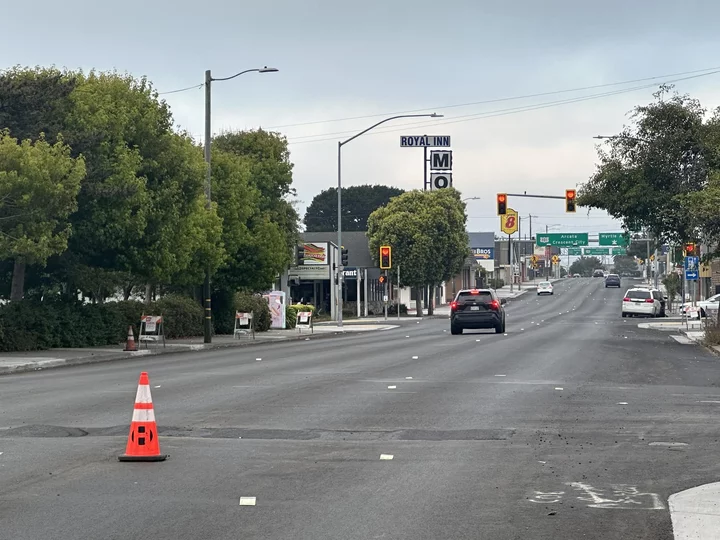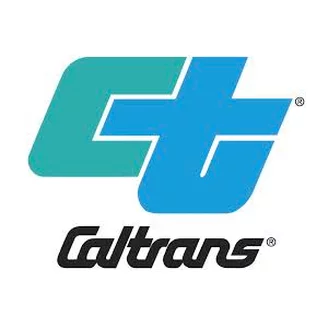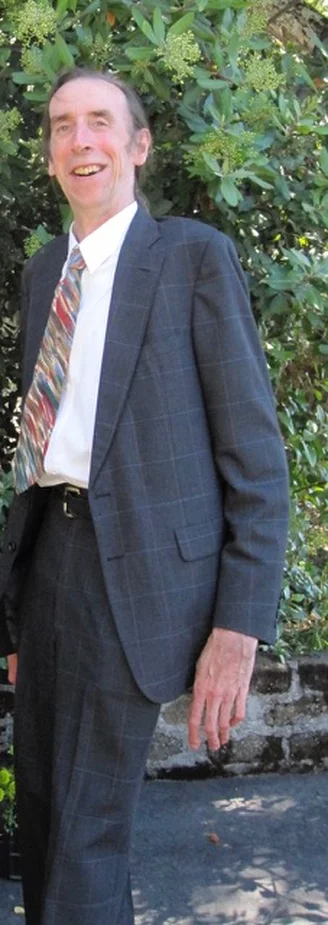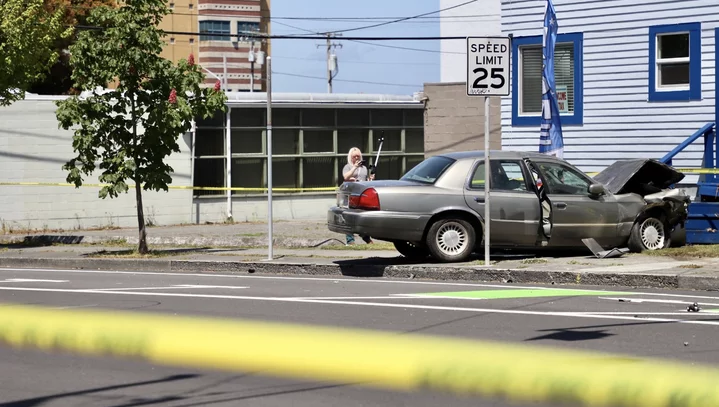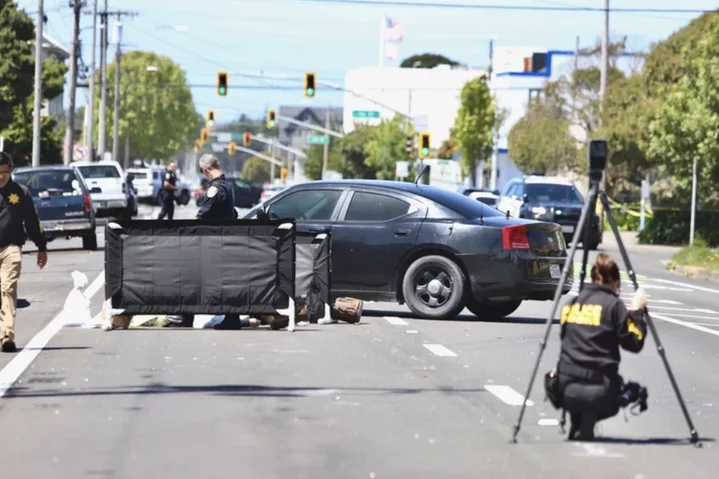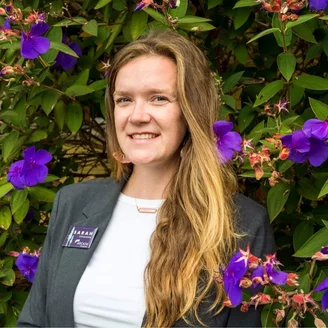California Boosts Spending to Help Students Earn Math and Science Degrees
Li Khan / Tuesday, July 9, 2024 @ 7:34 a.m. / Sacramento
Students discuss their work in class at the MESA center at American River College on April 25, 2024. Photo by Cristian Gonzalez for CalMatters
Alina Kralya tinkers with a microcontroller for one of her computer science projects at American River College. Nearby, a group of other first-generation college students sit in green and blue chairs, chatting about their math homework. It’s a typical scene at this community college space for students in the Math, Engineering, and Science Achievement program, called MESA.
Two years ago, Kralya was in her first year at an engineering university in Ukraine when the Russian invasion and the subsequent war uprooted her family. After moving around Eastern Europe, they sought refuge in sunny Sacramento with $300 in their pockets.
Between language barriers, a brand new academic system and trying to make sense of trigonometry, it hasn’t been an easy journey for the 20-year-old, who dreams of going into robotics. When she needs tutoring or just a quiet place to study away from her younger siblings, she comes to the MESA center.
She’s still buzzing with excitement about a recent conference for female engineers she attended in San Jose. The program covered her entrance fee and transportation costs, and staff helped her set up her LinkedIn profile for the event. “Listening to all those successful ladies in STEM, oh my gosh, it was so nice,” she said.

Computer science major Alina Kralya outside the MESA center at American River College on April 25, 2024. Photo by Cristian Gonzalez for CalMatters
California allotted millions of dollars in 2022 to create the same program at community colleges across the state. Currently, 91 out of 115 campuses have programs established, with three more set to create one next year. The state hopes the expansion will reduce barriers to STEM jobs for “underserved and underrepresented” students. As the initiative rolls out statewide, questions remain about how long the funding will last, and how the programs can track how well they’re working.
To enroll in the program, students must be both low-income and a first-generation college student. The students’ parents can’t hold a bachelor’s degree in any country to meet the first-generation requirement.
Less than 1 in 5 community college students in California who want to transfer to a university succeed in doing so within four years, according to a report from the Public Policy Institute of California. For Black and Latino students, transfer pathways are even weaker: 13% for Black students and 16% for Latinos.
Beyond bolstering transfer rates, the goals for MESA include increasing representation of Blacks, Latinos, and Native Americans in STEM industries. In 2021, 9% of STEM workers nationwide were Black, while 15% were Hispanic or Latino, according to a report from the National Center for Science and Engineering Statistics.
“The community needs people to be in these positions as doctors, as scientists, as engineers, as computer scientists who actually understand the community that is being served,” said Edrina Rashidi, the officer of advocacy for the Community College Association of MESA Directors, who recently lobbied for more legislative support for the programs.


First: Barbie Schmitt chats with interim MESA project lead Samuel Morrison in the MESA center at American River College on April 25, 2024 Last: The Diane Bryant STEM Innovation Center at American River College. Photos by Cristian Gonzalez for CalMatters
Students in the program have access to a range of support, such as tutoring, academic counseling and help finding internships or scholarships. The physical centers offer computer equipment, textbooks and a place to study. Program directors work closely with students to connect them to resources.
As of fall 2023, 4,279 students were enrolled at a MESA program on their campus, according to state data.
State funds expansion of MESA programs systemwide
Four years ago, MESA programs had a $2.5 million statewide budget. After lobbying efforts from the MESA directors association, the program now has a $39.4 million statewide budget and was written into the California Education Code. Over 50 colleges have taken advantage of the funds in the last two years, nearly tripling the number of programs from 34 to 94.
Each college received a total of $428,576 for the 2022-23 school year, in the form of a grant from the state. This past year and every year through 2027 they’ll get at least $280,000 each. However, the state chancellor’s office expects colleges to eventually start covering some of the costs, so that the programs can stay afloat if the state money disappears, according to the statewide MESA project monitor Stephanie Ricks-Albert.
The state grants will be up for renewal in 2027. Rashidi said more legislation is being written that could establish a minimum funding level, to guarantee stable funding for the programs.
The program also exists in different forms across the state and nation. In California, many universities and high schools have MESA programs or clubs that are overseen by the UC Office of the President with a budget of about $7 million.
Inside a MESA program
Computers, STEM textbooks, whiteboards, a free-to-use printer and a coffee machine occupy the MESA center at American River College, housed on the first floor of the sleek new Diane Bryant STEM Innovation Center. A line of university pennants hangs from one wall; on another, three astronauts smile from a poster that reads, “FROM MESA TO NASA.”
Over 200 students have access to this space. It’s where tutors like Marco Alaniz, who is also a MESA student studying computer science, can often be found. He’s had a love for programming since his mom bought him a computer as a little kid, but he struggled when he started college the first time over 20 years ago, and ultimately dropped out.
“I just wasn’t prepared,” Alaniz said. Because his parents never went to college, they didn’t have the experience to help him navigate school or teach him time management habits. “So really, growing up, I was kind of on my own on that, just kind of figuring things out.”

Computer science major, and MESA tutor, Marco Alaniz in the Diane Bryant STEM Innovation Center, which houses the MESA center at American River College on April 25, 2024. Photo by Cristian Gonzalez for CalMatters.
After about 15 years of working odd jobs to pay the bills, Alaniz enrolled in American River College in 2019 to give his computer science degree another shot. For the past year he’s tutored MESA students. It doesn’t pay enough for him to quit his job so he can take classes full time, but he really enjoys breaking down difficult concepts for his fellow classmates, and it’s even made him consider a career in education.
Samuel Morrison, the college’s interim MESA project lead, explained that the cost of living is one the biggest challenges for the low-income students he serves. He helps connect them to scholarships and internships, as the programs are required to do. One creative way the college has found to financially assist its students is to create paid projects with faculty mentorship and research opportunities students can apply for.”
“So students are finding, OK, this is a stipend that I can use to pay for gas to get to school, or I can use to supplement food costs,” Morrison said.
Still, the college lacks a designated MESA academic counselor. Kralya, the Ukrainian student, explained that the general counselors she’s seen are not always familiar with STEM-specific transfer programs, which can differ between universities. Adding financial aid to the mix makes things even more complicated; Kralya and Alaniz both had to declare multiple majors to get certain transfer requirements covered by financial aid.
“That’s why we have to find a really good counselor who can tell us this, because this information is not listed anywhere,” Kralya said.
The state requires the programs to have designated counselors, but getting an in-house counselor can be a lengthy and complicated process, Morrison said. He hopes to have one on board by the spring of 2025.
Students can also sign up for field trips, which include conferences and college tours. Students this semester visited the Sacramento State University planetarium, attended the Women in Engineering conference in San Jose, and toured UC Berkeley and UC Santa Cruz.
At programs across the state, students who are either low-income or first-generation, but not both, can still access certain resources, such as tutoring and counseling, but can’t go on field trips or receive paid research opportunities. There are currently 1,345 of them enrolled systemwide, called ASEM students, or “Friends of MESA” at some colleges.
Growing pains as programs roll out systemwide
Two years after new funding opened the doors for more programs, many still need to hire staff, find the required minimum 500 square feet of space to house the center, or recruit students to officially get off the ground.
Just hiring a program director to lead the program can be a lengthy process. A year and a half after receiving its grant, the program at Laney College in Oakland is still without a director. The college’s dean of math and sciences, Inger Stark, appointed math instructor Kyla Oh as the program’s faculty lead for the program in the interim.
“It has definitely slowed us down,” said Stark. The bulk of the work falls on Oh, who teaches fewer credits so that she has time to focus on the program. Stark squeezes the administrative side of the program into her workday as a dean.
Right now, the state money covers the entire program, which launched in April with an initial cohort of 14 students. Stark is determined to ensure the program stays afloat through any changes in the funding, but she’s spent enough time in her community college district to have seen many “beautiful initiatives” get weeded out.
“It is heartbreaking,” she said. “A huge amount of work can fall on the ground.”
The need for more granular program data
Tracking MESA programs in a comprehensive way is not easy. Some basic data is available through public dashboards, but directors want easy access to more in-depth information about their programs to help make sure they’re meeting their goals.
“We actually have no way of measuring our success, still, with the Chancellor’s Office,” said Rashidi, the lead advocate for MESA directors.
Basic information, such as the total number of MESA students in the system, is available through the California Community Colleges Chancellor’s Office public data tool, DataMart. However, that information isn’t broken down by race, gender or major. Granular data could give program directors the ability to quickly check if their efforts to reach students from underserved backgrounds are working.
Limited information on MESA student success is publicly available. Of the MESA students who first attempted to complete a transfer-level math course in the 2021-22 school year, 79% passed within one year, compared to a 54% completion rate for the general student body, according to the Transfer-Level English and Math Completion Dashboard.
CalMatters requested MESA transfer statistics and racial data from the Chancellor’s Office. According to the data, about 62% of MESA students were Hispanic or Latino as of December 2023, while 4% were Black.
To count transfers, the Chancellor’s Office counted students who were in MESA in one school year, and then enrolled at a university the next year. By this metric, MESA programs collectively transferred 1,010 students after the 2021-22 school year, including 563 Hispanic or Latino students and 23 Black students.
Nearly half of MESA students enroll at a university within four years of taking their first community college class, as of 2017, the most recent year complete data is available. Students were considered to be MESA students if they participated in the program at any point during their first three years in the community college system.
The Chancellor’s Office will analyze the status of the programs at the end of the current grant cycle, and the results could affect how much money programs will receive in the future, according to an emailed statement from Melissa Villarin, a spokesperson for California Community Colleges. Any additional funding would be based on “program and campus metrics,” according to the statement.
###
Khan is a fellow with the College Journalism Network, a collaboration between CalMatters and student journalists from across California. CalMatters higher education coverage is supported by a grant from the College Futures Foundation.
CalMatters.org is a nonprofit, nonpartisan media venture explaining California policies and politics.
BOOKED
Yesterday: 3 felonies, 11 misdemeanors, 0 infractions
JUDGED
Humboldt County Superior Court Calendar: Today
CHP REPORTS
Us101 N / Herrick Ave Ofr (HM office): Assist with Construction
0 Us101 (HM office): Assist with Construction
ELSEWHERE
RHBB: 29-Year-Old Drowns on Lake Shasta
RHBB: Mendocino County’s newest neighborhood Fire Safe Council gets right to work
RHBB: Road Construction in Eureka Starting Today Through August 1 on a Number of Streets
Governor’s Office: Governor Newsom signs legislation 7.28.25
Your Morning Commute Through Eureka Could Be Slowed This Morning
LoCO Staff / Tuesday, July 9, 2024 @ 7:06 a.m. / Traffic
Caltrans
Caltrans release:
Attention U.S. 101 travelers in Eureka:
Starting Tuesday at 5 a.m., northbound 101/Fifth Street in Eureka will be reduced to one lane at K Street for emergency repairs. All three lanes are expected to be reopened by noon. This closure is unrelated to the ongoing ADA improvement project in the area. Motorists are asked to drive with caution and use alternate routes if possible.
OBITUARY: Steven Allen Harris, 1952-2024
LoCO Staff / Tuesday, July 9, 2024 @ 7:05 a.m. / Obits
Steven Allen Harris
September 4, 1952 –
May 17, 2024
Steve Harris was born in Berkeley to Marjorie Jean (neé Peth) Harris and Clarence Alfred Harris, where Clarence worked as an Electrical Engineer at the Lawrence Radiation Laboratory. Steve was the youngest of three, with older sisters Barbara and Patricia. The family relocated to Los Altos in 1963, where Clarence took a job at the Stanford Linear Accelerator and Marjorie worked as an Assistant Librarian. There, Steve lived at the family home on Russell Avenue until he graduated from Awalt High School in 1970 and left to attend Humboldt State University in Arcata.
At HSU, Steve earned a B.S. and M.S. in Natural Resources. His masters thesis examined the relationship of fog and the coastal redwoods. In Steve’s youth he worked in a variety of nature-oriented jobs for the National Parks Service, U.S. Forest Service, on boats as a marine fisheries observer, and an environmental consultant. His favorite job was serving as a wilderness ranger in the Trinity Alps northeast of Arcata.
The last nine years of his career were spent working to assure that CalTrans staff and construction contractors complied with environmental permit requirements. During this time, he became an expert on the bats that sleep on the underside of the Yolo Causeway east of Davis, and the salamanders that live along Highway 101 north of Santa Rosa.
Due to his tall stature and distinctive gait, Steve was a familiar figure in and round Arcata for decades. His likes were contra dancing, old-time music, singing with the Arcata Interfaith Gospel Choir, making and playing a mandolin, fencing, foraging for wild mushrooms, playing chess and blowing soap bubbles.
He disliked having strangers ask him how tall he was, and Steve would typically answer, “81 inches.” The more dull-witted questioners would often reply “No, really, how tall are you?”, to which Steve would respond, “I just told you,” and stride away.
He also did not like being asked if he played basketball, to which the answer was a curt, “No.” Steve’s sport was hacky-sack, where his long legs let him cover lots of ground. Those legs also helped him move through a forest at an amazing speed that left those of lesser stature running to keep up.
Steve lived out his final years in a 1940-vintage bungalow landscaped with native plant species. He was visited by the turkeys that roosted in a nearby creek. Deer frequently bedded down in the comfort of his woodsy front yard.
Steve was a shy, kind and loyal man who, once he came to know and like you, was your friend for life. He had a passion for native plants and protecting the environment.
Steve had cheated death multiple times in his life, surviving cancers, a severe head injury, and problems with his circulatory system, all complicated by the scoliosis he was born with. His health gradually worsened over time, and in the end, his heart and lungs just couldn’t keep up with the demands of that big frame.
The Grateful Dead and Emmylou Harris were some of Steve’s favorite music makers. On his final day, the ICU nurse was a Dead fan who kindly served up hours of tunes from Jerry Garcia and Emmylou to send him home smiling.
Steve was predeceased by his parents, Clarence and Marjorie Harris of Los Altos, and sister, Barbara Harris, of Utah. He is survived by sister, Patricia Harris, of Sacramento.
Steve’s ashes will be scattered in Humboldt County. All are invited to a Celebration of Life at the Humboldt Unitarian Universalist Fellowship Hall, 24 Fellowship Way, in Bayside on Friday, September 20, at 1:30 pm. Please bring hors-d’oeuvres and light desserts to share at the potluck.
###
The obituary above was submitted on behalf of Steve Harris’s loved ones. The Lost Coast Outpost runs obituaries of Humboldt County residents at no charge. See guidelines here.
OBITUARY: Mildred June (VanNorstran) Goad, 1935-2024
LoCO Staff / Tuesday, July 9, 2024 @ 7:04 a.m. / Obits
Mildred June (VanNorstran) Goad passed away peacefully in Eureka
California on March 21, 2024
She was born on July 15, 1935, in Harriman Tennessee to Charity Estella (Israel) VanNorstran and Fred VanNorstran.
June grew up in Mossy Grove Tennessee with her parents and six siblings, Ira, Johnny, Dora, Lola, Jane and Lois.
On September 5, 1950 she married Berry Goad. They were able to celebrate their 70th wedding anniversary in 2020 shortly before Berry passed away.
In 1965 June, her husband Berry, and their five children moved cross country from Tennessee to Blue Lake, where she lived until her passing.
June had several careers throughout her life, but the job she enjoyed most was working for Harper’s Bazaar. She was a very fashionable woman and loved being the first to unpack and see the latest style in clothing.
In 1979 her husband Berry became the ranch foreman for Vic Guynup. She embraced her role as a rancher’s wife, and her delicious southern home cooking fed many ranch hands, family, church members and even a few orphaned puppies until they retired in 2001.
Throughout her life June always turned to God. She found comfort, joy and healing in worship and the church community. She secretly delighted in being able to play the piano for its members at several local congregations. She cherished the gift that her father had taught her and passed it along to a few of her family members.
Many friends and family have fond memories of June. Or Mamaw as she was known to her grandkids. From making biscuits and gravy to picking blackberries or raspberries for freezer jam. Her love of fast, fancy cars and the wonderful, crocheted blankets she gifted that always felt like one of her warm hugs. Family gatherings at her home were always memorable and filled with food, fun and laughter but most importantly, love.
June is survived by her children, Deborah (Ed) Rasmussen, Veronica (Zak) Peltier, Rick (Rita) Goad. Her grandchildren, Bridget (Nathan) Steeves, Justin Goad, Jessica Swanlund, Josh (Lucy) Rasmussen, Chad (Megan) Swanlund, Charity (Shay) Hetz, Laquessa Goad and Chanda Goad. She has 12 great grandchildren and three great-great-grandchildren.
June was preceded in death by her mother Estella VanNorstran, her father Fred VanNorstran, siblings Ira VanNorstran, Johnny VanNorstran, Dora Adams, Lola Vincent, Jane Davis and Lois Solock, her husband Berry Goad, and her sons, Fredrick Goad and Michael Goad.
A celebration of life for both June and Berry will be held at a later date.
The family asks in lieu of flowers, to please consider donating to St. Jude Children’s Hospital in memory of June.
###
The obituary above was submitted on behalf of Mildred Goad’s loved ones. The Lost Coast Outpost runs obituaries of Humboldt County residents at no charge. See guidelines here.
McKinleyville Man Sentenced to 10 Years for Killing Former Girlfriend, District Attorney Says
LoCO Staff / Monday, July 8, 2024 @ 5:12 p.m. / Crime
PREVIOUSLY:
- McKinleyville Man Arrested on Suspicion of Murder After Shooting, Killing Former Partner, Sheriff’s Office Says
- Jury Convicts McKinleyville Man of Voluntary Manslaughter in 2023 Shooting, District Attorney’s Office Says
###
Press release from the District Attorney:
Today, Judge Steven Steward sentenced Daniel Forrest Rena-Dozier to serve 10 years and 8 months in prison for the April 8, 2023, killing of Mia Simone Felder. Ms. Felder and Mr. Dozier had been romantically involved prior to the killing which occurred at the McKinleyville residence of Mr. Dozier.
Mr. Dozier was convicted by a jury on June 6, of voluntary manslaughter, assault with a semi-automatic firearm, possession of silencer and possession of a firearm with the serial number removed. Prior to imposing the sentence, Judge Steward heard from many family members regarding their tragic loss and the everlasting impact of Dozier’s crimes.
DUI Suspect in Fatal Eureka Collision Admitted to Using Nitrous Before Driving, Says EPD
LoCO Staff / Monday, July 8, 2024 @ 4:48 p.m. / Crime
File photos: Andrew Goff
PREVIOUSLY:
- I Street Closed in Downtown Eureka Following Huge, Multivehicle Crash; Pedestrian Struck
- EPD Identify 66-Year-Old Pedestrian Killed in Yesterday’s Downtown Collision; Witnesses Asked to Come Forward to Assist Investigation
Eureka Police Department press release:
The Eureka Police Department is still actively investigating the May 22, 2024 fatal pedestrian collision that occurred on the 900 block of I Street in Eureka. However, at this point in the investigation and supported by the evidence collected during the investigation, a Ramey Warrant was issued for Maria Cuevas, 30 years old from Eureka, for violations of Vehicular Manslaughter with Gross Negligence and Hit and Run Causing Death or Injury. Additional charges of felony DUI causing bodily injury were submitted to the District Attorney’s office for review as Cuevas admitted to using Nitrous Oxide just prior to the collision.
Cuevas is currently in custody at the Humboldt County Correctional Facility on the above noted charges and is being held on $65,000 bond and a probation hold.
And Arcata City Councilmember Sarah Schaefer: She, Too, Has Launched Her Reelection Campaign
LoCO Staff / Monday, July 8, 2024 @ 3:33 p.m. / Politics
Press release from Sarah Schaefer:
Sarah Schaefer has been serving on the City Council since 2020 and is excited to announce the launch of her reelection campaign. “I am honored to serve my community that I was born and raised in, and I want to continue the work I am doing for the next generation of Arcata.”
Sarah is a history teacher and school administrator who has always had a deep sense of purpose related to public service and a strong connection to her community here in Arcata. During her tenure on Council she has served as Mayor and Vice-Mayor as well as serving as chair of the Redwood Coast Energy Authority board and Co-Chair of the Equity Arcata board. Sarah is not only an active councilmember with strong working relationships with city staff and community partners but is engaged in regional work for Humboldt County through participation in local boards. Through numerous study sessions and special meetings on the Gateway Area and General Plan, Sarah has proven her ability as Mayor to lead and facilitate discussion in a meaningful and productive way.
Sarah has strongly supported policies to generate housing and protect tenants in Arcata. This includes championing infill to protect our natural areas and agricultural lands and supporting the City’s rental assistance and rental inspection programs. Sarah brings the perspective as a renter to the City Council and wants to continue to work on issues that are important to renters in Arcata.
She is also an advocate for active transportation in Arcata, helping adopt the City’s complete streets policy and enhance the City’s bike lanes and trail network. Sarah knows that sustainable transportation options will help Arcata battle climate change and improve the livability of our community.
Sarah is endorsed early on by other local elected officials including Humboldt County Supervisors Mike Wilson and Natalie Arroyo. When asked about working with Schaefer, Arroyo said, “It’s a pleasure to work with Sarah on regional issues of significance. She is deft and conscientious when navigating big challenges, and leads with great skill. I trust her to keep doing an awesome job for Arcata and the redwood coast!”
Schaefer also has endorsements from Redwood Coalition for Climate & Environmental Responsibility (RCCER), Colin Fiske of the Coalition for Responsible Transportation Priorities (CRTP), and Tom Wheeler and Matt Simmons of the Environmental Protection Information Center (EPIC) showing her commitment to sustainability and environmental efforts. Colin Fiske of CRTP state that “Sarah is a thoughtful and effective leader with a strong record of putting Arcata’s social and environmental values into action.”
According to Sarah, “I am launching my reelection because I want to continue to serve Arcata and work to bring more varied and affordable housing options, economic development opportunities, and sustainable transportation to the Arcata Community.”


